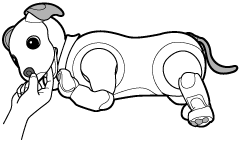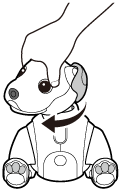Notes on use
On the packaging material
Please retain the packaging material. If needed, it provides a secure means of transportation for your aibo.
When turning off aibo in case of emergency
Press and hold the power button at the back of the neck for 2 seconds to turn off aibo. If this does not work, press and hold the power button for 10 seconds or longer to forcibly turn it off. A forced power off may cause loss of data and settings.
On handling aibo
-
Do not use aibo on a place from which aibo may fall off or on an unstable place, for example, with vibration or an uneven surface.
aibo may fall off or fall over, resulting in a physical injury or a malfunction of aibo.

-
Do not place fragile or dangerous objects around aibo.
aibo moves around on its own and may cause damage to your property or a freak accident.

-
Do not put your hands or fingers in gaps around aibo’s movable parts.
Your hands or fingers may get caught between aibo’s body and parts, resulting in a physical injury.

-
Do not lift or swing around aibo by grasping its head, ear, tail, front paw, back paw, or waist.
Also, do not twist any of these aforementioned parts.
Moving any of aibo’s movable parts beyond its limit may break the part, resulting in a physical injury.

aibo’s ears and tail come off from the body when they are forcefully pulled. This is designed for safety and does not indicate a failure. For attaching the removed ears and tail back to the body, see the following topics:
-
Do not use aibo outdoors to avoid ingress of water or foreign matters. Such ingress may cause a malfunction of aibo.
-
Do not use aibo on a hard floor, such as a concrete or asphalt floor, to avoid the risk of scratching aibo or its malfunction.
-
Do not use aibo on a slippery floor or a shag carpet. aibo may fail to sit up or move forward. It is recommended that you use aibo on a wooden floor or a carpet with short threads.
-
Do not exert excessive force on aibo to prevent its activities.
-
Keep aibo's movable parts free of anything that can restrict their movements, such as a sticker or a ribbon.
-
Do not lubricate aibo’s movable parts.
-
Do not allow a strong physical impact (e.g. dropping aibo) or exert excessive force (e.g. putting a heavy object on aibo) on aibo to avoid the risk of malfunction.
-
aibo’s operating temperature range is from 5 °C to 35 °C (41 °F to 95 °F). Use of aibo in an extremely cold or hot place where the temperature falls below or exceeds the range may cause a malfunction of aibo.
-
Do not leave aibo in a place subject to excessive dust or cigarette smoke.
-
Do not leave aibo in a place subject to extremely high/low temperatures or high humidity. The interior temperature of a closed vehicle parked under the blazing sun or in summertime rises considerably high. Leaving aibo in such a vehicle may cause deformation of aibo or its malfunction.
-
aibo’s network features are solely applicable to the networks in USA. Depending on the country or region, restrictions are imposed on use of radio waves. Use of aibo’s network features in such countries or regions may result in a violation of law.
-
Do not use aibo in an aircraft. Radio waves from aibo may affect the operation of the aircraft to cause an accident due to a malfunction of the aircraft equipment.
-
Do not use aibo’s network features when aibo is likely to approach within a radius of 15 cm (6 in.) from persons implanted with electric medical equipment, such as an implantable cardiac pacemaker or an implantable cardioverter defibrillator.
Radio waves from aibo may affect the operation of the electric medical equipment. Take either of the following actions to turn off the network features.
-
Slide the network switch on the torso to OFF.
-
Press and hold the power button at the back of the neck for 2 seconds to turn off aibo.
-
-
aibo’s sensor may malfunction when subject to intensive direct sunlight, such as by the window in daytime.
-
Protect aibo’s cameras and sensors from being scratched or soiled with dust and fingerprints. Scratches or soil residues on their surface can cause aibo's detection capabilities to deteriorate.
-
If residues of dust or fingerprints are found on aibo’s camera or sensor covers, do not touch them with bare hands. Instead, blow them off with a commercially available blower or wipe them off with a soft cloth.
-
Do not use aibo on a place where aibo might fall off, surrounded by obstacles, or within reach of small children. By falling or colliding, aibo may damage your property, cause a physical injury, or aibo may malfunction. Please be advised that Sony assumes no liability for any damage or loss that you may suffer as a result of such a fall or collision.
Moisture condensation
If aibo is brought directly from a cold place to a warm place, moisture may condense inside or on the surface of it and cause a malfunction of aibo. If moisture condensation has occurred, leave aibo without turning on the power.
Heat generation
-
aibo and the supplied AC adapter may generate heat while they are in use. Heat generation is caused by the operation of internal electric circuits or the electric current that flows during battery charge and does not indicate a malfunction. The amount of heat generated by aibo depends on its activity.
-
When aibo or the supplied AC adapter is extremely hot to the touch when compared to its usual state, press and hold the power button at the back of the neck for 2 seconds to turn off aibo. Unplug the power cord of the AC adapter from the AC outlet. Then, visit the online support page and see the troubleshooting information.
On handling the charging station
-
To let aibo charge its battery on its own on the charging station (self-charging) and get up from there, do not place objects, which may disturb aibo’s activities, around the charging station. See Where to place the charging station for more information.
-
Do not touch the charge connector with bare hands to avoid causing a bad contact.
-
Do not exert force on the charging station, for example, by putting your hand or elbow on it.
-
Do not step on or kick the charging station.
-
Do not exert a strong physical impact on the charging station or drop the station.
-
Do not leave the charging station in a place subject to abnormally high temperatures, such as inside a closed vehicle parked under the blazing sun, to avoid the risk of deformation or a malfunction of the charging station.
-
Do not allow the charging station to be exposed to water.
-
Avoid any type of liquids on the charging station. If liquid is spilled or collects on the charging station, immediately unplug the power cord of the AC adapter from the AC outlet. Then visit the online support page and refer the related FAQ troubleshooting information.
-
For more information about the charging station, see the following topics:
On charging the battery of aibo
-
Charge the battery under the condition where the ambient temperature is within the range from 5 °C to 35 °C (41 °F to 95 °F). If the temperature is out of this range, the battery may not be fully charged.
-
While you are charging the battery or using aibo, aibo’s body temperature may rise. This, however, does not indicate a malfunction of aibo.
-
Even if you do not intend to use aibo for an extended period of time, charge the battery every 6 months to keep it from deteriorating.
-
If aibo has not been used for an extended period of time, it may take more time to charge the battery.
-
If the battery power wears out in about a half of its standard battery life, the battery life may be coming to an end. For replacing the battery, visit the online support page and see the information about battery replacement.
On handling the AC adapter
-
Use the supplied AC adapter with the charging station. Use of any AC adapter other than the supplied one will cause a malfunction of aibo.
-
For connecting the AC adapter to a power source, use an AC outlet that is easy to access. When there is an issue with the operation of aibo, immediately unplug the power cord from the AC outlet to cut the power supply.
-
The supplied AC adapter is exclusively designed for use in USA. Do not use the adapter in any other countries or regions, or with any other voltages.
-
Do not connect the AC adapter to an electronic voltage transformer designed for travelers to avoid the risk of heat generation or a malfunction of the adapter.
-
When you leave home, for example, for vacation and do not intend to use the supplied AC adapter for an extended period of time, unplug the power cord from the AC outlet.
-
The supplied power cord is exclusively designed for aibo’s charging station. It should not be used with any other electric devices.
Notes on the Auto photo/streaming feature of aibo
-
Use the Auto photo/streaming feature in compliance with the moral standards.
-
Taking photos of others and/or making such photos open to the public may result in a violation of privacy or portrait rights. Before you take photos of others, be sure to obtain their consent.
On handling the SIM card
-
The SIM card in aibo is solely provided for use with aibo. Do not use it with any other products.
-
When you removed the SIM card from aibo, be sure not to misplace it and watch over small children to prevent them from swallowing the card.
-
For removing the SIM card, see Features inside aibo's body (Button, Switch, SIM card slot).
On cleaning
-
When aibo or the charging station is soiled with small particles and dust, gently wipe them off with a dry, soft cloth.
-
Do not use any volatile agent, such as alcohol or paint thinner, to avoid damaging the finish.
On Wi-Fi communication
Please be advised that you are expected to pay any necessary costs for connecting aibo to a Wi-Fi network.
On data compensation
In the event that your data is not recorded and thus unavailable for retrieval due to some reasons, such as a malfunction of aibo or a communication error, please be advised that Sony assumes no liability for compensating lost data.

